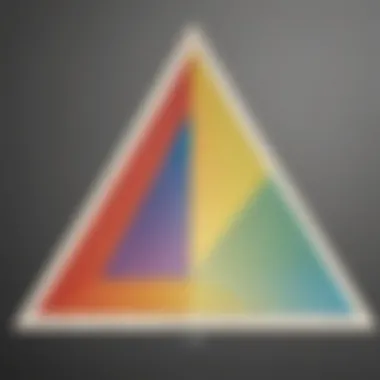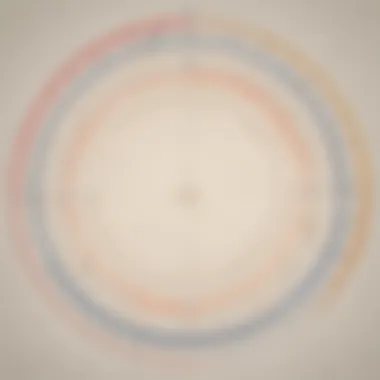Unlocking the Mysteries of Geometric Area Calculations


Creative Activities
Fun Quizzes
Incorporating fun quizzes related to calculating areas of figures can be an entertaining and educational method to reinforce learning. Quiz topics may include identifying shapes based on given dimensions, solving practical scenarios involving area calculation, and discerning the relationships between different geometric figures. By including various question types such as multiple-choice, fill-in-the-blank, and matching, quizzes can cater to different learning styles and challenge children to apply their knowledge. Through quizzes, children can consolidate their understanding of the formulas and methodologies involved in determining area, enhancing their retention and comprehension of geometric concepts. These quizzes serve as valuable tools for reinforcing knowledge and assessing proficiency in area calculation.
Fact-Based Articles
Explore an array of topics within the realm of area calculation, ranging from the fundamental area formulas of basic shapes to advanced concepts in geometry. Engaging content can present these mathematical principles in an accessible and engaging manner, breaking down complex ideas into digestible pieces for young learners. The articles aim to supplement understanding by providing additional resources such as interactive simulations, virtual manipulatives, and real-world examples of area calculation in everyday scenarios. By offering diverse topics and resources, learners can explore various facets of geometry, expanding their knowledge and application of area calculation beyond theoretical contexts.
Introduction
In the realm of mathematics and geometry, the concept of finding the area of various geometric figures holds immense significance. This introductory section serves as a gateway to a world of shapes and sizes where we unravel the secrets of calculating areas. Whether it be squares, rectangles, triangles, circles, or more complex shapes, understanding how to determine their areas is essential. By delving into different formulas and approaches, we embark on a journey to equip ourselves with the knowledge required for accurate area calculations.
Understanding the Concept of Area
The foundation of calculating areas lies in grasping the fundamental concept of area itself. Area represents the space enclosed within the boundaries of a two-dimensional figure. It is a quantitative measure that helps quantify the surface covered by a shape. By comprehending the concept of area, individuals can visualize and quantify the extent of space a shape occupies. Understanding area not only facilitates precise measurements but also enhances spatial awareness and geometrical reasoning, laying the groundwork for more complex mathematical concepts.
Importance of Calculating Area
The importance of calculating area extends beyond mere arithmetic computations; it is a tool that finds applications in various real-world scenarios and disciplines. By determining the area of shapes, individuals can solve practical problems related to land measurement, construction planning, and spatial arrangements. The ability to calculate area is crucial in fields such as architecture, engineering, agriculture, and design. Moreover, understanding how to calculate area fosters critical thinking skills and logical reasoning, sharpening individuals' cognitive abilities. It empowers learners to dissect complex structures into simpler components, paving the way for a deeper understanding of geometry and its applications in different contexts.
Basic Geometric Shapes


In this comprehensive guide to calculating the area of various geometric figures, understanding basic geometric shapes plays a fundamental role. Basic shapes like squares, rectangles, triangles, and circles serve as the building blocks for more complex calculations. They provide a solid foundation for learning about area and are crucial in real-world applications ranging from construction to art and design. By mastering the calculations for these simple shapes, individuals can enhance their problem-solving skills and apply mathematical concepts in practical scenarios.
Defining the Formulas for Squares and Rectangles
Exploring the formulas for squares and rectangles is essential in the realm of calculating area. The formula for squares involves multiplying the side length by itself, while rectangles require multiplying the length and width. These formulas showcase the direct relationship between the dimensions of the shape and its area, making them efficient and straightforward to apply. The simplicity of these formulas makes them popular choices for educational purposes, laying a strong foundation for more complex geometric calculations.
When defining the formulas for squares and rectangles, one must acknowledge their efficiency and accuracy in determining area. These formulas are beneficial as they provide clear instructions for calculating area without requiring advanced mathematical skills. The straightforward nature of these formulas simplifies the process of finding the area of regular quadrilaterals, making them indispensable tools in geometric computations.
Step-by-Step Calculation Methods
The step-by-step calculation methods for squares and rectangles offer a structured approach to determining area. By following a systematic process of multiplying the appropriate dimensions of the shape, individuals can accurately calculate its area. These methods guide learners through each necessary calculation, enhancing their understanding of the relationship between the shape's dimensions and its area.
The key characteristic of step-by-step calculation methods lies in their methodical nature. By breaking down the calculation into manageable steps, individuals can avoid errors and confusion, ensuring accurate results. This approach not only simplifies complex geometric concepts but also reinforces mathematical problem-solving skills, promoting critical thinking and logical reasoning.
When considering the advantages of step-by-step calculation methods, their systematic approach stands out. This methodical way of calculating area instills a sense of discipline and precision in learners, equipping them with valuable skills applicable beyond geometry. However, while these methods enhance understanding, they may require more time and effort compared to using direct formulas.
Advanced Shapes and Formulas
In this section of the article, we delve into the pivotal topic of Advanced Shapes and Formulas, which plays a crucial role in expanding our knowledge of geometric calculations. Understanding Advanced Shapes and Formulas is essential as it equips us with the tools necessary to tackle more intricate geometrical figures beyond the basic shapes. By exploring Advanced Shapes and Formulas, readers can enhance their problem-solving skills and approach geometric problems with a deeper understanding.
Areas of Trapezoids and Parallelograms
Formula Derivation and Applications
Diving into the specifics of Formula Derivation and Applications for Trapezoids and Parallelograms, we uncover the intricate process of deriving these formulas and their practical applications. The derivation of formulas for calculating the area of Trapezoids and Parallelograms sheds light on the mathematical principles underlying these shapes. By understanding the derivation process, readers gain insight into the relationships between different elements of these shapes, enabling them to apply these formulas accurately in various scenarios.


The application of these formulas in real-world problems showcases their significance in architectural design, engineering, and other fields where precise calculations are paramount. The versatility of the formulas for Trapezoids and Parallelograms allows for their widespread application, making them invaluable tools in geometric calculations. Understanding the derivation and applications of these formulas empowers readers to navigate complex geometric problems confidently.
Exploring the Area of Rhombuses and Kites
Properties and Formulas
Delving into the properties and formulas associated with Rhombuses and Kites, we uncover the unique characteristics that set these shapes apart. By exploring the properties of Rhombuses and Kites, readers gain a thorough understanding of their attributes, such as equal sides and diagonals. These properties play a crucial role in formulating the respective area formulas, providing a foundation for accurate calculations.
The formulas for Rhombuses and Kites offer a streamlined approach to determining their areas based on specific properties, simplifying complex calculations. By leveraging these formulas, readers can efficiently calculate the areas of Rhombuses and Kites in various contexts, from geometric design to spatial planning. Understanding the nuances of these formulas equips readers with the knowledge to handle irregular shapes and challenging geometric problems with confidence.
Calculations for Irregular Shapes
Exploring the calculations tailored for irregular shapes, we uncover a strategic approach to determining the areas of non-standard geometrical figures. The unique feature of calculations for irregular shapes lies in their adaptability to diverse shapes and sizes, offering a comprehensive method for measuring complex areas. By employing specialized techniques, such as breaking down irregular shapes into simpler components, readers can simplify the area calculation process and achieve precise results.
The advantages of using tailored calculations for irregular shapes include enhanced accuracy in area measurements and the ability to handle shapes that do not conform to traditional geometric standards. Despite the complexities of irregular shapes, the structured approach to calculations provides a systematic way to unravel their areas, fostering a deeper understanding of geometric concepts and problem-solving skills.
Composite Figures
Composite figures play a crucial role in this article as they involve combining multiple geometric shapes to form a more complex figure. Understanding how to calculate the area of composite figures is essential for tackling real-world scenarios where shapes are interconnected or overlapped. By delving into composite figures, readers can learn valuable skills in breaking down intricate shapes into manageable parts, computing individual areas, and summing them up for a complete area calculation. This section will provide insights into the significance of composite figures within the realm of geometry and practical applications.
Strategy for Finding Area of Combined Shapes
Dividing Complex Figures into Manageable Parts


Dividing complex figures into manageable parts is a strategic approach that simplifies the process of determining their total area. By breaking down intricate shapes into smaller, more familiar components, individuals can accurately compute the areas of each section before summing them up. This method enables a systematic breakdown of complex geometries, making the calculations more manageable and less prone to errors. Emphasizing dividing complex figures into manageable parts optimizes precision and efficiency in area calculations, making it a preferred technique in this article. Its organizational structure allows for a structured analysis of shapes, facilitating a smoother and accurate area computation. Although dividing figures into parts may require attention to detail, the advantages in terms of accuracy and clarity outweigh any potential complexities, making it a valuable strategy for handling composite geometries.
Summing Individual Areas
Summing individual areas involves adding up the calculated areas of each partitioned section to obtain the total area of the composite figure. By meticulously computing the areas of individual parts and combining them, one can accurately determine the overall area of the complex shape. This step is crucial for consolidating the calculated regions into a unified value, offering a comprehensive understanding of the composite figure's total area. Summing individual areas streamlines the process of area calculation for complex shapes, providing a structured method to ensure the accuracy of the final result. Its integration in this article underscores its significance in simplifying the evaluation of composite geometries and fostering a systematic approach to calculating areas. While it may require meticulous attention to detail, the precision achieved through summing individual areas enhances the overall accuracy and reliability of area calculations in composite figures, making it an indispensable component of this guide.
Real-World Applications
In the realm of geometry, understanding the practical implications of calculating areas is paramount. Real-world applications bridge the gap between theoretical knowledge and practical usage. By delving into real-world scenarios, individuals can grasp the significance of area calculations in various fields. This section will shed light on how these calculations play a vital role beyond textbooks and classrooms.
Utilizing Area Calculations in Everyday Scenarios
Examples in Construction and Architecture
Construction and architecture thrive on precise measurements and accurate calculations, making the utilization of area calculations indispensable. Whether determining the flooring needed for a room or the materials required for a structure, area calculations contribute to the efficiency and cost-effectiveness of projects. Architects and engineers heavily rely on area calculations to design buildings, ensuring that every square foot is optimized and utilized efficiently. The meticulous nature of construction requires a deep understanding of geometric principles, emphasizing the practical significance of accurate area calculations.
Applications in Agriculture and Landscaping
In the realms of agriculture and landscaping, area calculations serve as guiding tools for land management and crop cultivation. Farmers and landscapers utilize these calculations to measure fields, plan irrigation systems, and optimize crop yields. Understanding the area of land plots allows for effective utilization of resources, leading to sustainable agricultural practices and visually appealing landscapes. The precise measurement of areas in agriculture and landscaping influences decisions regarding plant spacing, soil nutrient distribution, and overall farm layout. Harnessing the power of geometric calculations enhances productivity and fosters environmentally friendly practices.
Conclusion
In concluding our comprehensive journey through calculating the area of various geometric figures, we must emphasize the critical importance of grasping this fundamental mathematical concept. Understanding how to find the area of shapes is not merely a skill but a gateway to unlocking a deeper comprehension of the world around us. By mastering area calculations, individuals develop problem-solving abilities, spatial reasoning skills, and a keen eye for detail. This knowledge is not only practical but essential in fields like architecture, engineering, and even everyday tasks such as designing a room layout or organizing a garden space. Furthermore, the process of calculating area instills a sense of precision and accuracy, honing one's attention to detail and fostering a methodical approach to problem-solving. As we wrap up our exploration of area calculations, remember that this knowledge is a powerful tool with far-reaching implications in both academic and real-world settings.
Summary of Key Points
As we reflect on the key points discussed throughout this article, one paramount aspect stands out - the significance of area calculations in understanding geometric shapes. From the basic formulas for squares and rectangles to the complex derivations for trapezoids and parallelograms, each shape presents a unique challenge that tests our mathematical acumen. By dissecting these shapes into manageable parts and summing their individual areas, we uncover the secrets to accurately calculating the total area of composite figures. This process not only enhances our spatial reasoning but also sharpens our problem-solving skills, laying a solid foundation for tackling more advanced mathematical concepts in the future.
Encouragement to Explore More Shapes
Our exploration of calculating the area of geometric figures is just the beginning of a fascinating mathematical journey. By delving into the realms of geometry, we open the door to a world teeming with diverse shapes, intricate formulas, and endless possibilities for discovery. As you embark on your own mathematical explorations, remember to embrace the challenges that arise, for it is in unraveling the complexities of shapes like rhombuses, kites, and irregular figures that we truly expand our mathematical horizons. Seek out opportunities to apply your knowledge of area calculations in real-world scenarios, whether it be in architecture, art, or even puzzles and games. By fostering a curious and inquisitive mindset, you will not only hone your mathematical skills but also develop a profound appreciation for the beauty and precision of geometric shapes.







